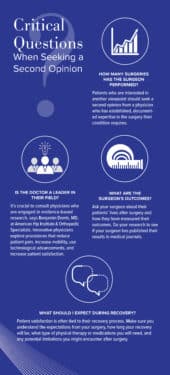For orthopedic surgery, additional opinions can revise the treatment course
Adam Chopp was a freshman athlete, playing football for Olivet College in Michigan, when he tore the labrum in his left hip during a game. He thought surgery would quickly fix the problem, but after four surgeries to the area, he still had pain and limited function.
About a year ago, his condition worsened again. “I’m very stubborn,” says Chopp, now 30. “I usually say, ‘Oh, I’ll just push it off.’ I can bear through the pain. But I walk with a limp. I can’t squat. I can’t run. There are all these little movements that cause so much pain for me, and it wears on you mentally and physically.”

He found himself facing surgery — again. But this time, there was a difference. Chopp sought a second opinion from a new doctor. And that doctor identified the root cause of his injury and repeated pain: an underlying condition — slipped capital femoral epiphysis. If Chopp had been properly diagnosed initially, he may have been able to have the correct surgery the first time, rather than multiple surgeries later.
That second opinion, from Henry Finn, MD, medical director of the Chicago Center for Orthopedics & Robotic-Assisted Surgery, made all the difference to Chopp, who underwent total hip arthroplasty on his left hip with Finn in January 2021.
While many orthopedic cases do not require multiple revision surgeries, diagnostic error is a common issue in medicine. A second opinion can make a big difference, providing individuals with a revised diagnosis.
For instance, only 12% of patients who visited the Mayo Clinic over a two-year period retained their referral diagnosis after seeking a second opinion there, according to a 2017 study in the Journal of Evaluation in Clinical Practice. About 66% of patients received a refined diagnosis, and 21% walked away with a completely different diagnosis from the one they had when they were referred.
Importance of another outlook
Benjamin Domb, MD, founder and medical director of the American Hip Institute & Orthopedic Specialists (AHI) in Des Plaines, sees some patients in need of arthroscopic hip surgery who have been initially misdiagnosed. Such patients may suffer for months before seeking second — or third or fourth — opinions at AHI.
“With the internet and the availability of information, patients do more research than they’ve ever done before,” Domb says. “They’re seeking a higher degree of specialization than has existed in the past.”
When people seek second opinions, they are looking for an accurate diagnosis, new treatment options, and good communication with their physician, Finn says. “[Patients] want to feel a connection to their doctor when they have a very serious health problem.”
When faced with surgery for an orthopedic injury or condition, a second opinion can help individuals gather information they need to feel comfortable with the surgical approach or to investigate new options.
People are generally fearful of spine surgery, and some seek less invasive surgical treatments, says Kern Singh, MD, co-director of the Minimally Invasive Spine Institute at Rush University Medical Center.
Most of his patients come to him seeking a second or third opinion, he says. Other doctors have told them they need open surgery and hospitalization rather than the minimally invasive outpatient procedures that he specializes in.
Balancing varied opinions
To search for a second opinion, people can start by asking family members, friends, and other physicians for recommendations.
When meeting with an orthopedic surgeon for a second opinion consultation, individuals should bring in past medical records — such as surgical reports, documentation of any previous opinions, or imaging such as CT scans and MRIs — to provide the physician with a complete picture of their condition.

Singh believes each individual patient needs to feel confident in the decision to move forward with orthopedic surgery amid varying opinions. “They should always do what’s comfortable for them, so it’s a no-pressure situation,” he says.
Singh posts videos of patients’ stories on social media. “Patients really relate to other patients reporting their surgical outcomes,” he says. “A lot of patients come in and tell me, ‘I saw those videos of the same surgery I’m going to undergo, and I’m really happy to be here.’”
Despite having been through four previous surgeries, Chopp feels confident in his new diagnosis. He looks to the future with hope: “My quality of life is going to be a lot better than what it is right now.”
Originally published in the Spring/Summer 2021 print issue.

Katie Colt is a writer living in the Chicago area. Her work can be found at The Huffington Post, The Washington Post, and more.










